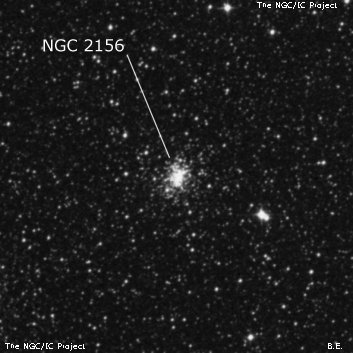
John Herschel discovered NGC 2156 = h3005 on 23 Nov 1834 and recorded "pF; S; irreg R; psbM; 25". He observed this cluster on 5 sweeps and other than brightness, the descriptions are similar.
James Dunlop possibly made the first observation (D 197) on 27 Sep 1826 and noted a "small faint round nebula". His position, though, while correct in declination is nearly 19' too far east and might also apply to NGC 2172, which is 12' SW of his position. Another possibility, given by Herschel, is that D 196 = h 3005 = NGC 2156. Dunlop's position is 8' ESE of this object.
Pietro Barrachi sketched the immediate field on 3 Jan 1886 with the 48" Melbourne Telescope and described this cluster as "B; S lE; bM; Resolvable or at the least several stars in it and generally mottled appearance. He drew the cluster lumpy and elongated N-S, with a couple of stars resolved around the edges. In 1926 Robert Innes called NGC 2156 a "fine cluster of stars; 12 to 15 mag" (26-inch refractor, Union Observatory).
600/800mm - 24" (4/11/08 - Magellan Observatory, Australia): this is the first of four bright clusters in a 16' field! At 200x it appeared bright, fairly large, elongated N-S, ~1.2'x0.8', sharply concentrated. At 350x a couple of stars were resolved in the halo and the central core was just broken up into several clumps or knots with a couple of very faint stars resolved. Located 6.9' NW of the impressive cluster globular NGC 2164.
Notes by Steve Gottlieb